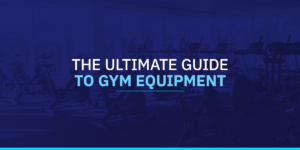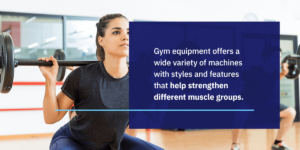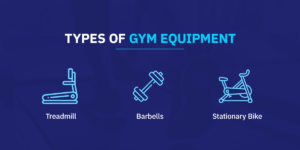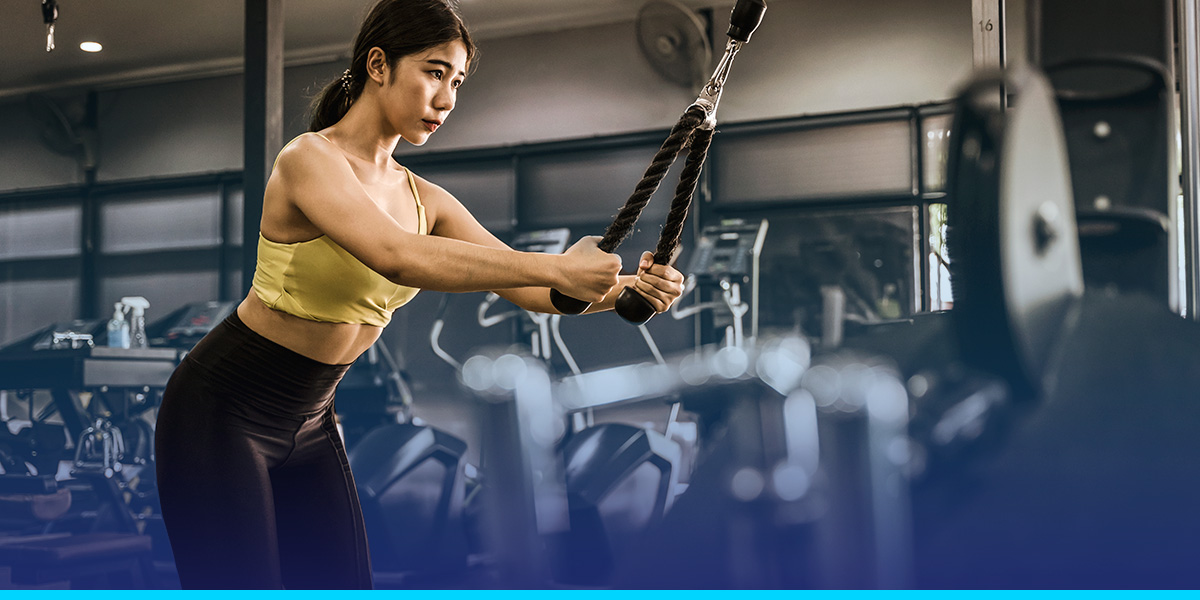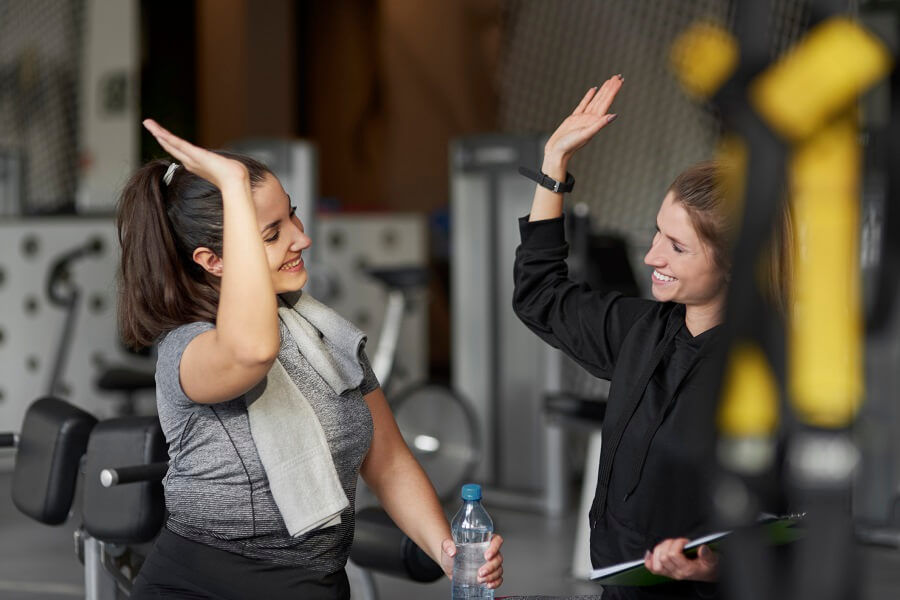The Ultimate Gym Equipment Guide
The Ultimate Gym Equipment Guide
Posted on: August 8, 2023 in GymsGoing to the gym for the first time doesn’t have to be stressful, even if you don’t know how the machines work or where to begin when creating your workout routine. In this complete gym machine guide, we’ll cover some benefits to using gym equipment, a few popular types of machines and helpful descriptions of how to use them. Let’s get started!
What Are The Benefits Of Using Gym Equipment?
Gym machines offer a wide variety of benefits, from building muscle strength to adding more excitement to your workout. Here are six main advantages to using gym equipment:
1. Increases Strength and Endurance
Whether you’re using gym machines for cardio, a treadmill to build leg strength or resistance bands to stretch your muscles, using exercise equipment can help enhance your physical stamina and strength. Gym machines typically have adjustable settings, weights and sizes to accommodate different levels of expertise and stamina.
With consistent practice, you can start to advance these settings gradually to help build strength and endurance. Whether you’re new to the gym or have been working out for years, there’s always an opportunity to help your body grow stronger.
2. Builds Muscle Mass
If you’re looking to boost muscle mass, size and strength as quickly as possible, regular bodyweight exercises may not be enough to achieve this. Gym equipment uses external resistance, which can help you build muscle faster and more efficiently — helping you accomplish your fitness goals in a shorter amount of time. For example, squatting with barbells will likely drive faster results than squatting without free weights.
3. Promotes a Safer Workout
You’re less likely to get injured when using gym equipment if you’re using it correctly and not overworking your muscles. Your body can tire easily when exposed to extreme workout exercises, but a gym machine can help prevent injury by better matching the amount of force to muscle strength and controlling the path of motion. This way, your body can receive a safer and more productive workout.
4. Adds Variety
Gym equipment offers a wide variety of machines with styles and features that help strengthen different muscle groups. These machines are also designed to improve flexibility, aerobic and anaerobic exercise and other areas. With this variation of machines and equipment, you can mix and match exercises to create a workout routine personalized to your liking. You can also determine how to best utilize this window of time, taking brief breaks between sets as needed.
5. Helps With Weight Loss
Gym equipment allows for full-body workouts that help you burn calories and get in shape. Machines such as treadmills, rowing machines, ellipticals and stationary bikes are particularly helpful for losing weight.
Weight loss gym equipment also makes it easy to track your progress throughout your journey. Many machines have built-in heart rate monitors — you can view your activity level as you work out, receive an overview of calories burned and the exercises you performed that day, as well as how long you spent on each one. Seeing these results can help motivate you to keep working hard.
6. Prevents Health Problems
A lack of physical activity can result in long-term health issues such as diabetes, obesity, heart disease and high blood pressure. Thankfully, gym machine exercises can help reduce the risk of developing these issues and promote a healthier lifestyle overall.
Gym equipment workouts can improve mental health in addition to physical health. Serotonin and dopamine are released during these exercises, helping you feel stronger, happier and more relaxed.
What Are The Types of Gym Equipment?
Here are some common types of equipment you’ll likely find in local gyms and weight rooms. Each of these is designed to target certain muscle groups and areas of the body and they provide an array of other benefits as well.
Treadmill
Running on the treadmill is an excellent form of cardio workout and weight loss training. It’s a great way to burn calories, improve bone density and build muscles. You can alternate between walking, running and jogging, allowing for adequate cooldown periods as needed. Treadmills in gyms often include advanced features that display your distance, heart rate and the number of calories burned. You can also adjust your speed and incline to help your body build endurance over time.
The treadmill is a great machine for beginners to start out with, as it’s easy to use. However, you must be strategic when planning your treadmill workout — the intensity of your workout should determine how often you use it. Low-impact walking and jogging can be done daily, but for longer and more rigorous runs, it’s better to use it on alternate days.
To ensure it’s not too steep, start with a slight incline and gradually increase the steepness over time. For a consistent treadmill workout, you should try to use it at least three days a week.
Barbells
Weightlifting is a great way to integrate strength training gym equipment into your regular workout routine — it helps you build muscle, strengthen joints and bones, burn fat and improve cardiovascular health. With lots of patience and practice, you can work to build this skill over time.
Despite looking complex and even slightly intimidating, barbells can be beginner-friendly. However, you should familiarize yourself with proper form techniques before you begin lifting. If you don’t feel comfortable using barbells right off the bat, you can start with dumbbells first.
Below are some basic barbell exercises to apply to your workout. We strongly recommend having someone spot you when attempting these, whether you’re a beginner or expert:
- Barbell back squats
- Barbell front squats
- Angled barbell presses
- Barbell bench presses
Stationary Bike
A stationary bicycle workout is a great way to tone your thighs, strengthen your legs and lower body muscles, burn fat and improve brain function. There are two main types of stationary bikes — upright and recumbent.
A recumbent stationary bike includes a full-body seat for back support and pedals positioned directly in front of your body. On the other hand, an upright stationary bike does not offer back support, uses a smaller seat and has pedals positioned underneath your body. As a beginner, you might consider a recumbent bike, as it doesn’t require you to hold yourself up as you pedal. However, you can select whichever one fits your preference.
For beginners, it’s recommended that you start slow and gradually increase your intensity and time from there. Try pedaling for a total of 25 to 35 minutes, starting with low intensity for the first few minutes and working your way up. Once you reach the highest intensity level, slowly work your way back down to the lowest intensity to complete your workout.
Weight Machines
A staple at any gym, weight machines allow you to get a great workout with everything you need contained in one machine. There are many different types, and most target certain muscles or muscle groups in the upper body or lower body.
Using a weight machine is perfect for easing into fitness if you are new to working out, or taking your strength training to the next level. Weight machines are often named for the muscle or muscle group they’re targeting — for example, the Bicep Curl machine or Calf Raise machine. Many machines often have labels with pictures of how to perform the exercise or even QR codes so you can look up what to do.
Popular machines for the upper body include:
- Bicep Curl
- Tricep Extension
- Shoulder Press
- Chest Press
- Seated Row
- Lat Pulldown
Popular machines for the lower body include:
- Leg Press
- Leg Extension
- Leg Curl
- Calf Raise
- Hip Abductor/Adductor
Most weight machines have adjustable seats so you can ensure you have correct form while exercising. For example, if you are shorter or taller than average, take a moment to change the height of the seat.
When you first begin using a weight machine, start with a lighter weight and then move up as you get stronger. You can adjust the weight by small increments, like 2.5 pounds or 5 pounds, to find the right level of resistance.
Smith Machine
No gym equipment guide is complete without a Smith machine. One of the many benefits of a Smith machine over a traditional bench is the machine holds the bar for you, allowing you to focus on your form.
When using a Smith machine, it’s important to perform every rep carefully and under control. If you’re not sure if your form is right, one of the trainers at 5 Bridges Health & Fitness can help.
You can use a Smith machine for a variety of exercises, including:
- Squats to work your legs overall
- Split squats to focus on your glutes and quads
- Deadlift to strengthen your back, glutes, hamstrings and core
- Bent over row for your lats and other back muscles
- Incline bench press for your pecs
How to Use Gym Equipment
Now, let’s take a look at how to use five other types of gym machines and equipment. If you’re new to the gym, we hope this information will aid you in using them for the first time.
1. How To Use A Rowing Machine
A rowing machine is a highly-efficient piece of cardio gym equipment, providing a full-body workout that strengthens your arms, legs and back. One of the best things about a rowing machine workout is that it can be as high-intensity or as low-impact as you please. Here are the basic steps to using a rowing machine for the first time:
- Sit upright on the seat with your back straight, knees bent and feet secured in the holding straps. Grab the oar in front of you with both hands.
- Push your legs forward to straighten them out. At the same time, pull the oar toward your chest while bending your elbows out to your sides.
- Bend your knees and lean forward to bring yourself back to the position you started with.
- This completes one stroke — repeat as many times as desired. You can straighten your legs at a slower pace first and gradually increase your speed from there.
2. How To Use An Elliptical
An elliptical machine targets the biceps, triceps, calves, glutes and quads. It’s a great way to improve balance and coordination as well. Follow these steps when using an elliptical for the first time:
- Step onto the elliptical machine pedals and grab the handles in front of you.
- Push the pedals in a forward motion with your feet to turn on the monitor.
- Select a preset program from the screen or set your own workout using the manual setting — ask a trainer if you need help navigating the monitor.
- Continue the pedaling motion throughout your workout and keep your grip on the handles. The handles will move in sync with the pedals.
- Adjust your pedaling resistance using the up and down arrows on the machine and regularly monitor your heart rate displayed on the screen.
3. How To Use Resistance Bands
Resistance band workouts use stretchy strips of rubber that come in various styles, lengths and thickness levels. They’re a great way to improve athletic performance, balance and flexibility. Many people like to use resistance band exercises as a form of rehabilitation for injuries and complications as well.
There are various resistance band exercises you can apply to your workout routine. Here are a few examples and how to execute them:
- Squats: Step onto a light resistance band with your feet shoulder-width apart. With one hand on each side, hold firmly onto the ends of the band and squat repeatedly. You should feel a burning sensation in your glute and leg area.
- Bicep curls: Stand on your resistance band and use your left or right foot as an anchor point. From here, perform a bicep curl. Tuck your elbows, keep your spine straight and bend your knees slightly as you execute the curl.
- Core kicks: Sit on an exercise mat and wrap your resistance band around one foot. Hold the ends of the band with both hands. Keeping the foot with the resistance band in the air, lean back at a 45-degree angle. Bring your knee into your chest, then press out for about 30 seconds. Repeat this exercise with your other leg.
- Lateral shoulder raises: Stand on your resistance band using your right or left foot as an anchor point. Raise both arms out so they’re parallel to the floor — your body should form a letter “T” position. Lower your arms and repeat this exercise.
- Back rows: Sit on the floor with your legs straight out. Stretch your resistance band across the bottoms of your feet, grabbing both ends of the band with your hands. From here, pull your hands back in a rowing fashion repeatedly, as you would with a rowing machine.
4. How To Use A Stair Climber
A stair climber machine workout is an excellent way to strengthen your core muscles, hamstrings, calves and glutes. It’s an easy technique for beginners to learn and can help improve balance and coordination as well.
Here’s a general idea of how to use a stair climber if you’re unfamiliar with this machine:
- Stand upright on the machine and try to keep your shoulders back — you can lean your hips forward slightly, but too much slouching can put unnecessary pressure on your lower back.
- Take smooth, even steps while keeping your whole foot on the pedal. Try to avoid quick, hopping steps — this can be tough on your calf muscles.
- Maintain a steady pace throughout your workout, about 60 to 80 steps per minute.
We hope this section was useful in learning the proper ways to use various pieces of gym equipment. If you have any questions about these or need a visual demonstration of how to use gym machines for arms, legs or other muscle groups, feel free to ask a trainer or instructor at your local gym for assistance.
Choosing 5 Bridges Health & Fitness
Choosing the right gym is an integral part of developing an equipment-based workout routine. At 5 Bridges Health & Fitness, we are committed to helping you achieve your fitness goals and a healthier lifestyle.
When you enroll in one of our group exercise classes or work with one of our experienced personal trainers, you can discover the right style of workout to best meet your body’s needs. You can also work closely with skilled instructors devoted to helping you accomplish your workout goals.
We offer a variety of group fitness classes at 5 Bridges Health & Fitness:
- Cardio: Our cardio exercise classes are designed to get your blood pumping and build endurance. From cycling to dance classes to other resistance training sessions, we have something in store for everyone.
- Yoga: Need a break from high-intensity workouts? Try out one of our low-impact yoga classes designed to help you improve flexibility and build strength while harmonizing the body, mind and spirit.
- Zumba: Our Zumba classes combine upbeat dancing with high-intensity cardio — making for both an effective calorie-burner and a fun and lively workout session.
- Senior: Maintaining physical activity becomes even more important as you get older, which is why we offer various senior fitness classes designed to target the major muscle groups, improve flexibility and build strength.
5 Bridges Health & Fitness is also happy to announce our new virtual membership program — contact your local gym to learn more!
Contact Us Today
Let us help you find the right style and flow for your personalized workout routine by getting in touch with one of our skilled Harrisburg trainers. For questions regarding our workout classes and schedules, or to sign up for your very own membership, contact 5 Bridges Health & Fitness today!


